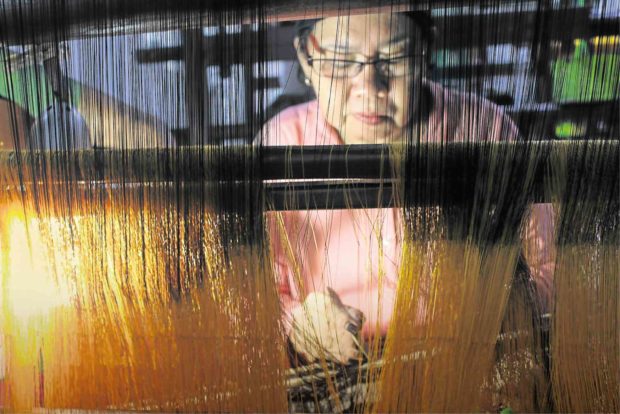
Normina Collie, Maguindanao’s master weaver, takes to her loom. In the last 40 years, she has been weaving the “inaul.”
BULUAN, MAGUINDANAO — Normina Collie started weaving the traditional Maguindanao cloth “inaul” when she was only 12 years old. Now 52, she is the province’s lone surviving master weaver and still creates the cloth with passion.
“There is passion in doing it, every day I weave, it’s in my system,” Collie, who is fondly called Babo Normina by acquaintances, told the Inquirer in the vernacular. “I feel weak if I don’t weave or make inaul for ‘malong’ (wraparound).”
Worn only by royals in the olden days, inaul has been touted to be the showcase of Maguindanao’s “artistic expression.”
“This is (made) only in Maguindanao and (could) not (be found) in other areas,” Babo Normina beamed as an aide directed the light to her piece.
The indigenous art of inaul making, however, is disappearing. The province hoped to revive interest in it by holding the 2nd Inaul Festival on Feb. 8-14 at the capitol complex in Buluan town, which was why Babo Normina and a dozen other weavers were rushing work to meet the demand for more than 300 pieces of cloth during the event.
Provincial push
Gov. Esmael Mangudadatu said most of the younger generation no longer wore inaul malong, preferring jeans and shirts. Others who still wear it use the common “Chinese cotton” cloth, which is mass-produced.
“If not for the governor, the Maguindanao weaving tradition would have died and replaced by ordinary cloth commercially displayed in malls and made by unrecognized weavers,” Bai Sarika Pendatun, the president of Maguindanao’s rural improvement club, told the Inquirer at the exhibit building.
Funding for the revival of the inaul weaving industry has been incorporated in the P15-million budget of the Gender and Development office.
Pendatun said the weavers organized and established a “technology know-how” project to teach the skills to young women. In each of the 36 municpalities, 10 women were trained for a month, she said.
Nulfarid Ampatuan, festival director, said Babo Normina’s groups had already trained 300 women.
Bai Sarika Pendatun (top) shows off the “inaul” fabric in a bag on display at the festival, along with the inaul cloth (top, left) and men’s vests (above).
Learning from grandma
Babo Normina said she learned the skill from her grandmother, who also learned it from from Maguindanaon elders.
“My grandmother was a well-known weaver,” she recounted. “I learned weaving by stealing her works while she was asleep or out somewhere.”
She said she would meticulously watch as her grandmother turned strands of thread into inaul.
“Whenever my grandmother went out, I would take her seat and started weaving then keeping my produce out of her sight,” she recounted.
But one day, her grandmother found out what she was doing so she started teaching her the proper way of weaving the fabric, Babo Normina said.
“She transferred all her knowledge to me, that was how I learned the job,” she said.
Pendatun and Babo Normina said inaul was so special that it should not be washed by tap water and soap.
“Coconut water is used as it prevents the special silk from fading, it prevents the cloth from shrinking,” Pendatun said. “We discourage the use of soap.”
Demand for inaul is rising, Ampatuan said, pointing out that orders were already coming in from the United States, Europe and Southeast Asia.
For now, the orders are made on a “person-to-person” basis only, he said, while the provincial government was working on formal marketing programs for bulk demand.
An inaul takes about three days to complete, according to Pendatun. It sells for P2,500-P5,000, depending on the design and the kind of thread used, including imported silk.
Evolution
For this year’s Inaul Festival, Ampatuan said the provincial government wanted to highlight innovations on the use of inaul and preservation of the tradition.
The cloth is not only for malong or dress but also for such products as bags, wallets and computer holders.
Among those on display at the exhibit area are more than a dozen pieces of inaul cloth, with the oldest produced in 1920 by the great-grandparents of Hadji Abdullah Luntayan.
“We are exhibiting how the inaul evolved in Maguindanao,” Ampatuan said. “Looking at it, shows the color of royalty was violet,” he said.
“Some part of it was already torn due to old age,” read a brief historical note attached to the old cloth.
Ampatuan said the “unique art” had been passed on from generation to generation but managed to retain its original form.
“This is my life,” Babo Normina said as she delicately and carefully intertwined strands of threads on her fingers, “I will always be weaving until I die.”